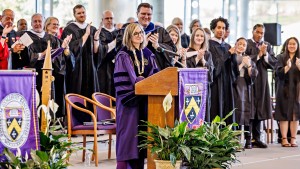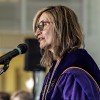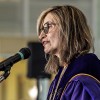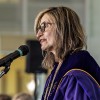The following is the prepared text of the inaugural address delivered by Julie Kornfeld during her installation ceremony as the 20th president of Kenyon on April 13, 2024.
Watch a recording of the ceremony.
Thank you. I’m so grateful to be here with you all today, and to have the great honor of leading this amazing institution.
Thank you, Aileen, for your kind words and for your unending support. To the Board of Trustees, I want to thank you for your commitment to this very special place and for trusting me to lead this institution that you hold so dear. To the faculty, staff, administration, students and community members here in Gambier and Mount Vernon — thank you for the warm welcome that you have extended to me and to my family. You have made this transition a truly wonderful one. In big and small ways, you have shown me why Kenyon is such a great institution and the right place for me and my family to call home. Milo — our family dog — was unable to join us this afternoon but has insisted that I share his gratitude for all the love that he has received on Middle Path since we arrived.
My predecessors in this role have powerfully shepherded Kenyon’s legacy of excellence in liberal education. Because of their leadership, our community has held strong for more than 200 years and is well poised to begin its third century. I am grateful to those who are here today, including Provost and former Acting President Jeff Bowman, whose wise counsel and guidance helped ease my transition to the College, and President Emeritus Georgia Nugent, who carved a path for me as Kenyon’s first female president. Thank you.
To the Inauguration Committee and everyone on campus who helped bring your vision to life, I want to thank you for all that you have done to make this week a very special one for the College. All of you have worked tirelessly and I am grateful for the many, many hours you have put in to ensure that this weekend is flawless and that no stone on Middle Path is out of place. Thank you.
I cannot envision today without the tremendous love and support of my family and friends.
My parents, Morris Kornfeld and Rose Stein, set me on an educational journey when I was young that has led me here. Although my father passed away when I was eleven, he infused in me a love of reading and learning that has lighted my way. My father was discouraged from going to college by his parents who felt that his ability to enter a trade and earn wages would be more useful to his family. But my father had a hunger to learn and a brilliant mind. After serving in the military and with the support of his brother and the GI bill, he became an electrical engineer. Without his courage and perseverance, I would not be standing here today.
My mother, Rose Stein, never had the opportunity to get a college degree. As a Holocaust survivor who was a witness to some of the worst moments of humanity, she knew the power of education and understands to this day that while so much can be stripped away from someone, their education can never be lost. She encouraged me to pursue opportunities that were not open to her. Both she and my father instilled in me a love for education and a strong belief that a road to a meaningful life and career was within my reach.
I want to acknowledge my husband, Fred Silverman, who has been my steadfast partner and the love of my life for 30 years. You have showed up for me each and every day — sometimes with a tuna fish sandwich when I have forgotten to eat and more times than I could ever possibly count with a wise word, a calm and steady hand and a corny Dad joke when it is most needed. I could not have this life and do this work without you by my side. And to our children, Dylan, Morgan and Ely — you are the sunshine of our lives and we are in awe of the amazing young adults that you have become. You make us proud. More importantly you make us giggle and be silly and you continually remind us that the future is bright. I love you so very much. And to Olivia — welcome to our family.
I want to take a moment to acknowledge the lifelong friends and colleagues that have traveled to be here today. Some of you have been in my life since Woodcrest Elementary School, and all of you have been by my side for the adventures — and twists and turns — that this life has brought to us. Your friendship and support are among the greatest gifts in my life.
To all of you here — I have seen the transformative power of a liberal arts education up close with my own three children. And I am deeply honored to champion this education as Kenyon’s 20th president.
Stepping into a presidency is an awesome responsibility at any time, but it feels especially daunting at this moment. Higher education has received an extraordinary amount of public attention. As a sector we face increasingly potent — even dangerous — headwinds. The rising temperature in state legislatures leading to interference with classrooms and curricula, the politicization of campuses leading to disruption and, in some cases, violence — have contributed to a growing mistrust and diminishing confidence in higher education.
It’s no wonder people keep asking me: “Why on earth would you want to be a college president?”
To this question, my answer is unequivocal. This work has never been more important. Full stop.
With higher education under scrutiny, we need to firmly demonstrate the value not just of a college education but a liberal arts education. We are the ones that can train the leaders we need to solve the complex societal problems we face. We need to show up for the liberal arts now more than ever, because if we don’t, this vital model of education will fall by the wayside.
We need to show up and prove our significance to society.
I have always lived my life guided by that simple principle: SHOW. UP.



